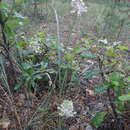Description
provided by eFloras
Bulbs usually clustered, ovoid-cylindric, 0.7--1.5 cm in diam.; tunic brown to red-brown, leathery, entire or splitting. Leaves shorter than scape, 0.5--1.5 mm wide, semiterete, adaxially channeled, smooth, sometimes scabrous-denticulate along angles. Scape 20--60 cm, terete, solid, smooth, covered with leaf sheaths for ca. 1/3 its length; outermost leaf sheath usually scabrous. Spathe 1- or 2-valved, persistent; beak ca. 2 × as long as limb, sometimes to 6 cm. Umbel globose, densely many flowered. Pedicels subequal, 1.5--2(--4) × as long as perianth, elongate in fruit, bracteolate. Perianth purple-red to pale red, rarely white; segments with darker midvein, oblong-ovate, 4--5 × 2--2.5 mm, apex shortly pointed; inner ones slightly longer than outer. Filaments subulate, equal, 1.5--2 × as long as perianth segments, connate at base and adnate to perianth segments. Ovary subglobose, with concave nectaries at base. Style exserted. Fl. and fr. Jul--Sep. 2 n = 16, 32.
- license
- cc-by-nc-sa-3.0
- copyright
- Missouri Botanical Garden, 4344 Shaw Boulevard, St. Louis, MO, 63110 USA
Distribution
provided by eFloras
Xinjiang (Altay Shan, Tarbagatay Shan, Tian Shan) [Kazakhstan, Russia; C Europe].
- license
- cc-by-nc-sa-3.0
- copyright
- Missouri Botanical Garden, 4344 Shaw Boulevard, St. Louis, MO, 63110 USA
Habitat
provided by eFloras
Dry slopes; 1100--3100 m.
- license
- cc-by-nc-sa-3.0
- copyright
- Missouri Botanical Garden, 4344 Shaw Boulevard, St. Louis, MO, 63110 USA
Synonym
provided by eFloras
Allium caucasicum Marschall von Bieberstein; A. dshungaricum Vvedensky; A. globosum Marschall von Bieberstein ex Redouté; A. gmelinianum Misczenko ex Grossheim; A. stevenii Ledebour.
- license
- cc-by-nc-sa-3.0
- copyright
- Missouri Botanical Garden, 4344 Shaw Boulevard, St. Louis, MO, 63110 USA
Allium saxatile: Brief Summary
provided by wikipedia EN
Allium saxatile is a Eurasian species of onion native to European Russia, Belarus, Caucasus, and the Altai Krai region in Siberia. The species was formerly perceived as including additional populations from central and eastern Asia but recent studies have resulting in splitting of the old species into several distinct species.
- license
- cc-by-sa-3.0
- copyright
- Wikipedia authors and editors

